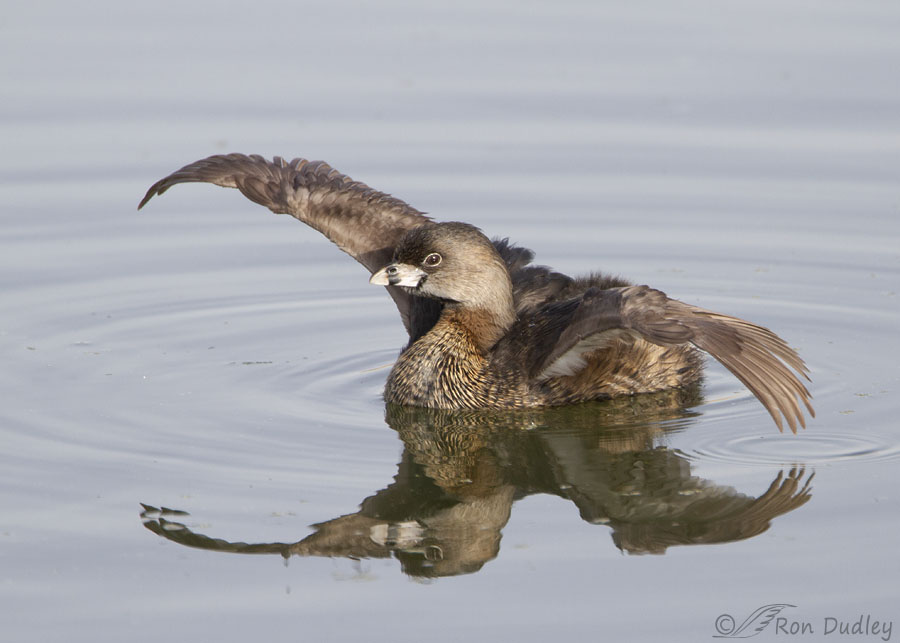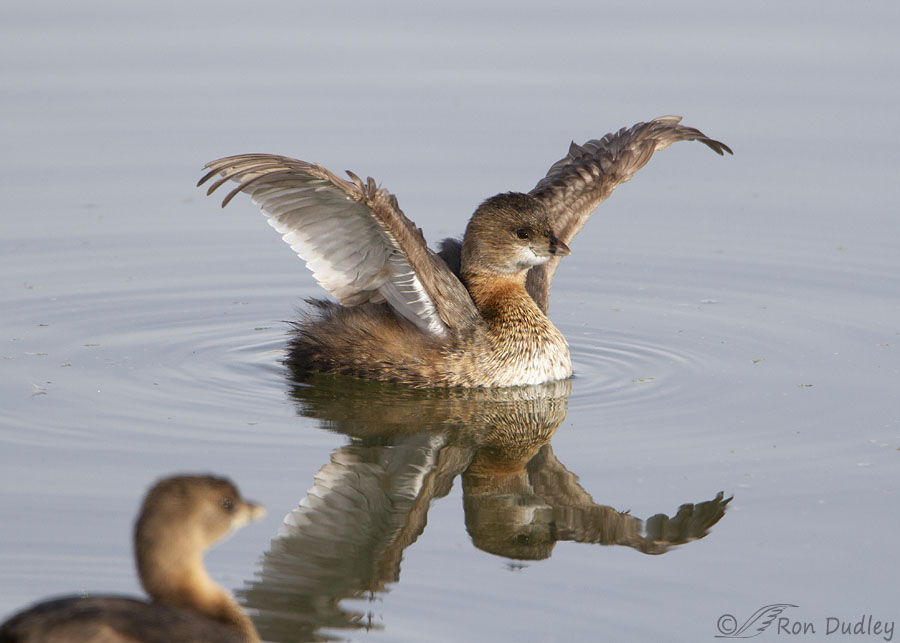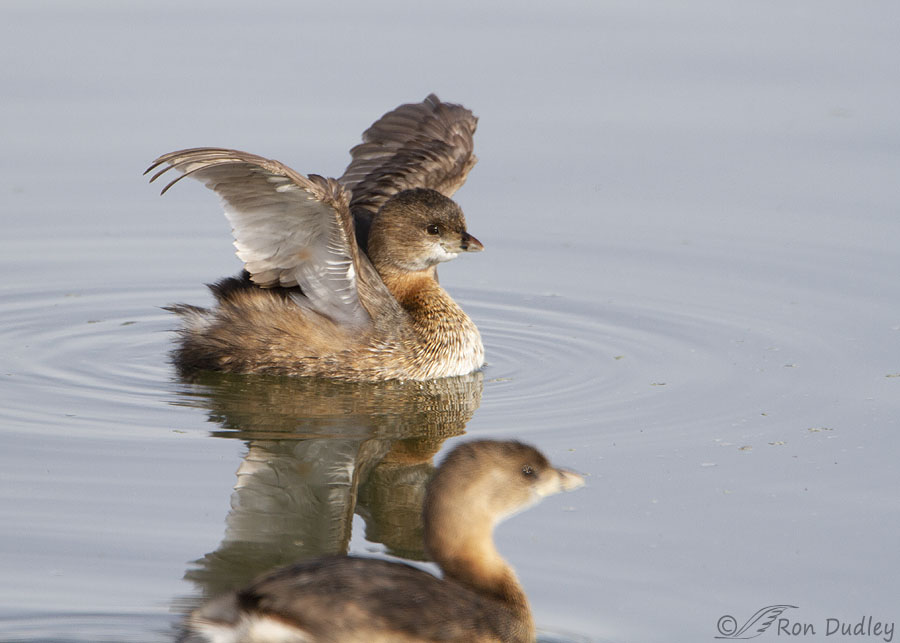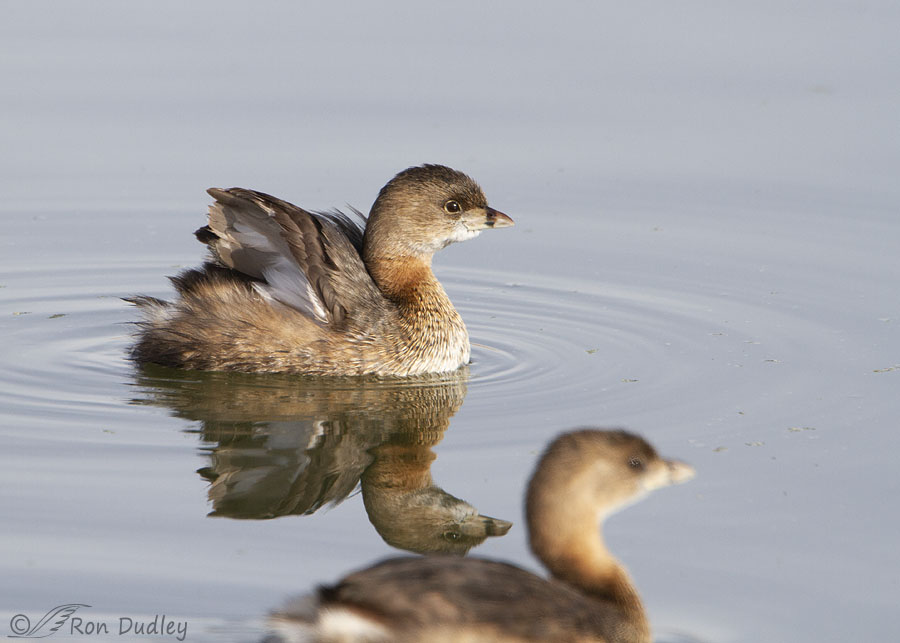I’ve spent hundreds of hours with Pied-billed Grebes over the years and this is one of the few times I’ve managed to document this fairly unusual behavior. Its purpose/function still eludes me.

The adult grebe was on the 4-way pond at Farmington Bay WMA when ‘he’ suddenly extended both wings horizontally. He held them in that position for an extended period of time, long enough for me to get many photos of him in that pose. There were no other grebes or other birds in his immediate vicinity but there were quite a few grebes fairly close by.
I was struck by the behavior because in my experience it’s unusual. These birds often partially raise their folded wings vertically but this horizontal, fully extended wing position held for a long time seemed out of the ordinary, although I have occasionally seen it at other times.
And it wasn’t the first time I’d seen this behavior that morning from what was probably the same bird.
Note: See the comment from David Harkins below and my response regarding whether or not it was “the same bird”.

Less than a minute before the first photo above was taken (based on the time stamps on my photos) he’d struck the same pose but this time there was another grebe slowly approaching him at an oblique angle.

Even though he slowly raised them slightly higher he kept his wings extended for the entire time it took the second grebe to slowly swim by, long enough for me to once again get multiple photos of the behavior.

When it eventually became obvious that the second grebe had no interest in him he immediately folded his wings and then both birds went about their normal business.
Perhaps we can infer that the behavior was some sort of threat or warning display. Since it was unusual I tried to research it but I came up empty. Even Cornell’s exhaustive Birds of the World account on Pied-billed Grebe behaviors doesn’t mention it.
I’m convinced the grebe wasn’t just stretching.
It may be folly to presume the behavior was an agonistic (aggressive) display directed at the second grebe. These photos were taken in late February which is precisely the time breeding behaviors begin in Pied-billed Grebes in North America. Males and females of this species look alike so it seems possible that the behavior was some kind of sexual display (sexual advertising), although once again Cornell doesn’t mention it that I could find.
So for now at least I’m calling it a mystery behavior.
Ron


Ron, a friend alerted me to your exquisite images and the discussion about the possible function of the observed behavior. Since I co-authored that Birds of North America (now Birds of the World) Pied-billed Grebe account you mentioned I thought I would pipe up, for what it’s worth.
As you and David Harkin already discussed photos 1 and 2 – 4 depict different birds. The first has some black on the “chin,” while the second is in full winter plumage. If you look at the depth (height) of the bill, most likely the first photo shows a male, while the second bird’s bill looks smaller (less high) which makes me suspect it’s a female (if you have a pair of Pied-bills next to each other the difference is very easy to see, in addition to the smaller overall size of the female).
I have seen this behavior many times, although usually not for more than 30 seconds to a minute. Of course with modern cameras that would give us plenty of time to shoot a hundred images or more.
I associate this behavior/posture with the late stage of drying out the wings after bathing (including wing-thrashing) and preening. Often, when the wings are folded closed after this behavior there’s a bout of wing-shuffling which is believed to help rearrange wing feathers properly.
Did you observe bathing and preening beforehand? And maybe even wing-shuffling after?
Another reason I believe this is regular maintenance behavior is because of the fact that two birds did it shortly after one another. Most maintenance behavior (also referred to as comfort movements) is “contagious.” Like our yawning. If one bird starts bathing this will often “set-off” other nearby birds into similar behavior.
The reason you didn’t find this listed with Pied-bill comfort movements is because that whole section is based on similar behavior described (and named) in ducks. Ducks don’t include “wing drying” and I forgot to include it. Hopefully in the next update.
The only other time I’ve seen Pied-bills hold out their wings like this was in young birds getting ready for their first (ever) flights. It was always on a windy day and the bird would sit facing into the wind for the longest time. Like gathering courage before doing something new. Obviously not the case in your images (wrong time of year and no wind).
That said, keep looking. That’s how new (to us) things are discovered.
Again, thank you for sharing these excellent images.
I’m delighted that you “piped up”, Martin. I’ve been a subscriber and a huge fan of Cornell’s BNA, now Birds of the World, for over a decade now and two of my photos are in the new edition of their “Handbook of Bird Biology”, a copy of which is sitting on my desk as I type this.
First, congrats to you and your co-author Robert Storer on an exhaustive and well written account about Pied-billed Grebes. I can only imagine how much time you both have invested in fieldwork observing these birds.
Fascinating that you say the behavior is contagious. I should have thought of that possibility myself – in my experience many behaviors in many species seem to be contagious.
These photos were taken some years ago so I can’t remember if there was any bathing or preening just prior to when they were taken. I wouldn’t be surprised if there had been preening but I doubt bathing because neither bird looks wet or damp to me.
I’m now convinced that your explanation is the most likely reason for the behavior in these two grebes I photographed. Thanks very much for clearing up the mystery.
And by the way, Martin – thanks to your input above I’m now going to make more concerted attempts at reliably sexing adult Pied-billed Grebes. It’s a skill I’d love to develop.
This was fascinating. I’m glad Ron pointed us back here to read this comment.
Last Friday I spent quite a bit of time and shot hundreds of photos of a Pied-billed Grebe demonstrating a sequence of behaviors, including this one. The bird was in a drainage ditch, so close to me I could hardly keep the whole bird in the frame. It was a sunny day with temperatures in the mid 40’s. During that time a Coot swam slowly by and the grebe completely ignored it. There were no other birds near by. The first photo I have shows it doing a leg and wing stretch. Then it spent some time grooming, finally plucking a feather and eating it. It then struck the pose you have documented for about a second, raised it’s wing for a brief moment before repeating the pose for another second or two, then extending its neck, opening its mouth and throwing its head back over its head (it did not vocalize). Soon after it began swimming away.
Interesting, John. You appear to be a skilled observer.
I have a ton of photos of grebes doing this at Farmington taken over many years. Some as recent as a few days ago. I always thought it was a way of sunning their wings like birds that lay prostrate on the ground looking like they are dying. Grebes spend their time in the water have to be more creative on sunning underparts.
Could be, April. I just don’t know. And neither does Dan Gleason in his comment below. If Dan doesn’t know it remains a mystery in my mind. Besides these birds were mostly facing the sun low in the sky so very little if any direct light or heat would reach their skin.
Grebe Yoga. The “Thunderbird” pose.
Kathryn
🙂
Whatever the reason, great shots Ron! Can we just call him a copycat of a Turkey Vulture?
We are getting light snow in the Kootenays so maybe you will get some too, very odd winter just like your Pied-billed Grebe!
Shirley, we’ve had a pretty good amount of snow in the mountains the last few days and even some in the valleys. It’s about damn time!
I like Marty’s thought, airing out the pits. The reflective images are beautiful — and the younger grebe is such a pretty little thing, wings up or not, for whatever reason!
Thanks, Chris. Yes, I like that reflection too.
Ron this is a typical pose for cormorants.. maybe he was raised by cormorants 🤣
A cormogrebe… 🙂
Perhaps they’re just airing out their pits — must get pretty damp under there. 😉
Whatever the reason for the behavior, I wonder what they’d think if they knew that it got a whole bunch of humans talking and speculating.
Gossip mongers…
😂😂
Like you, I’ve seen this behavior a few times, but I also have no explanation. It doesn’t fit simply stretching as they usually hold this pose for an extended time. And I’ve seen it in lone grebes so it doesn’t look like aggression, defense or breeding displays. I’ll let you know it I ever come across a good explanation, but for now, I guess it remains a mystery.
Thanks, Dan. When I was writing this post I was a little hesitant about calling it a mystery. Now I feel justified.
Colour me awed. And fascinated.
Where is Dr Doolittle when we need him.
C’mon out Dr., wherever you are.
Ron – 2nd response. Was reading David’s observations and I agree, but even more upon looking very closely the 2nd one also appears to me to be younger.
The water reflection in the first shot is gorgeous! The pose reminds me of guys on the beach flexing their biceps LOL.
Thanks, Kathleen. I see what you mean… 🙂
Very interesting behavior, Ron. I wonder if it is related to warming or drying its feathers, like a roadrunner does?
Thanks, Ed. I suppose it’s possible but personally I’m skeptical. But what do I know…
Excellent series Ron. I see them all the time at our lakes, but have never seen one raise their wings like this. Certainly could be an aggressive reaction to something only they know. I love reflection photos and made myself a Shutterfly photo book of the countless ones I have. Would have loved to have had that first one when I made it,
Many followers have said it, but it is so true that your posts are so much more than just outstanding photos.
Much appreciated, Everett. Like most everything else great photos day after day can get old after a while.
They’ll NEVER get old! 😉
Great captures. I’ve seen Turkey Vultures, among a few other species doing it to cool off or to warm up in early a.m.but this certainly doesn’t fit that. Also read in Sibley’s “What It’s Like to be a Bird’ where the eared Grebe on cold, sunny mornings will face away from the sun and raise it’s rump feathers exposing the dark underlying skin to the warm sunlight…not the case here but I found that fact interesting! So you have stirred an interest in your readers…thank you! 🙂
Thanks, Kathy. If Dan Gleason sees this maybe he’ll have some insight.
Very interesting behavior ans wonderful series of shots Ron!
Charlotte Norton
Thank you, Charlotte.
Beautiful photo with the reflection. 😀 Not being familiar with them I wouldn’t have given the horizontal wing raise a 2nd thought. Thermoregulation doesn’t seem likely in Feb. in northern UT tho “hot and bothered” could be I suppose. 😉
“Thermoregulation doesn’t seem likely in Feb. in northern UT tho “hot and bothered” could be I suppose.”
Now that brought a smile, Judy. Good play on words (I fixed your typo).
Thx for the “nimble fingers” (or spelling) fix…….
Not that it matters, but the grebe in the first picture doesn’t seem to be the same individual that’s in the other three. The first one has a black line along it’s mandible and a tawny chin color. The other lacks the black line and has a much whiter chin color. The behavior is interesting.
Good eye David, I think you’re probably right. These are older photos so I couldn’t remember for sure. Since they were taken less than a minute apart and the behaviors are the same I figured they were “probably” the same bird. I should have looked more closely.
I’ll update my post.
Well, I may have a clue for you. I posted about a grebe engaged in the same behavior, and a couple of people told me it was for thermoregulation. My photos were taken on a warm day, but it seems that the behavior’s not linked solely to excessive heat. In any event, it’s fun to know we’ve seen the same thing.
Thanks for the insight, Shoreacres. But these photos were taken on a February morning in northern Utah. I’m sure it was close to freezing so thermoregulation seems highly unlikely to me, at least in this particular case.
It will be interesting to see if others of your readers have some insight. And now I’ll explore a little further, too. Thermoregulation made such sense. Perhaps it’s an entirely different behavior, or even a behavior that has more than one purpose.